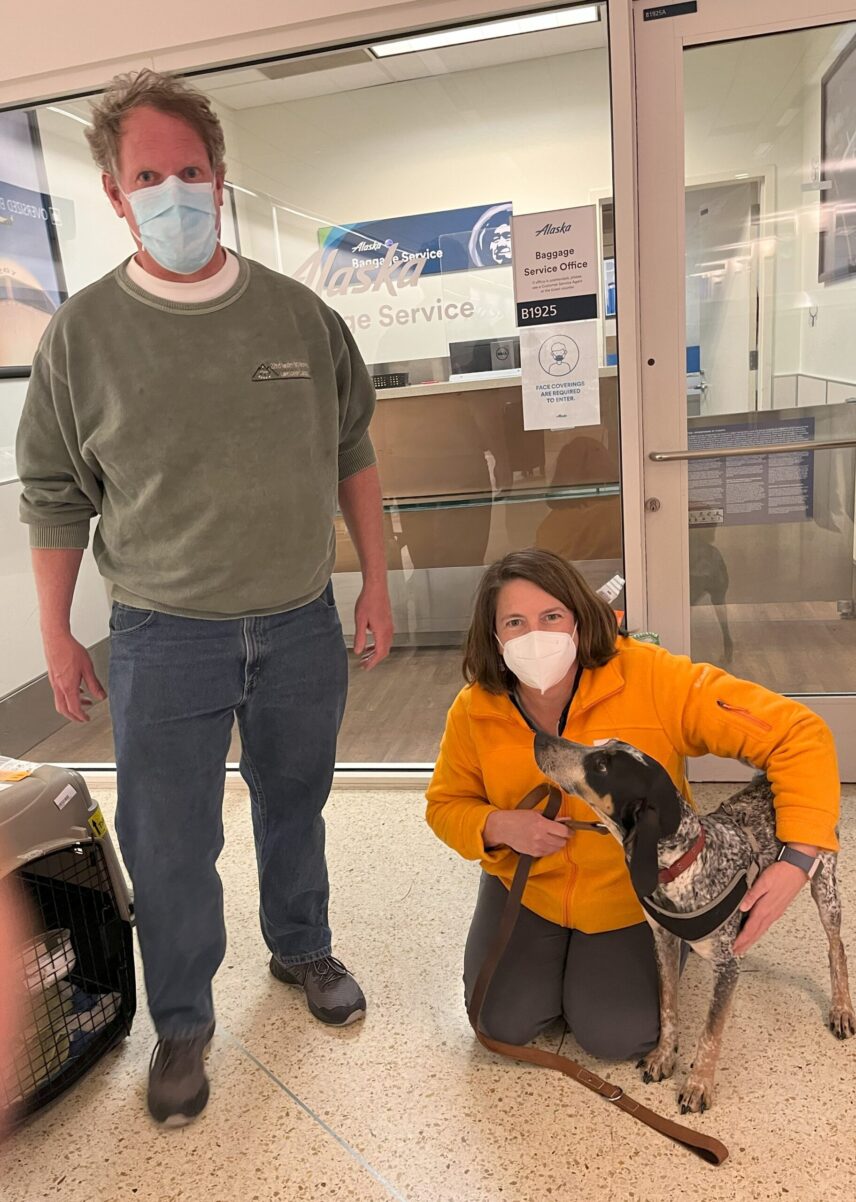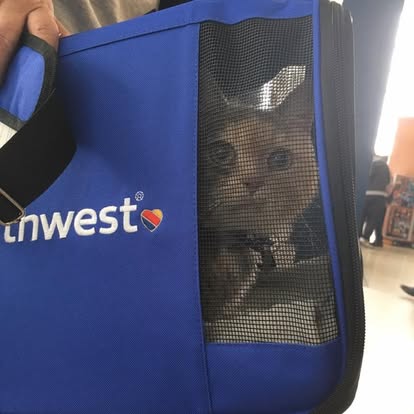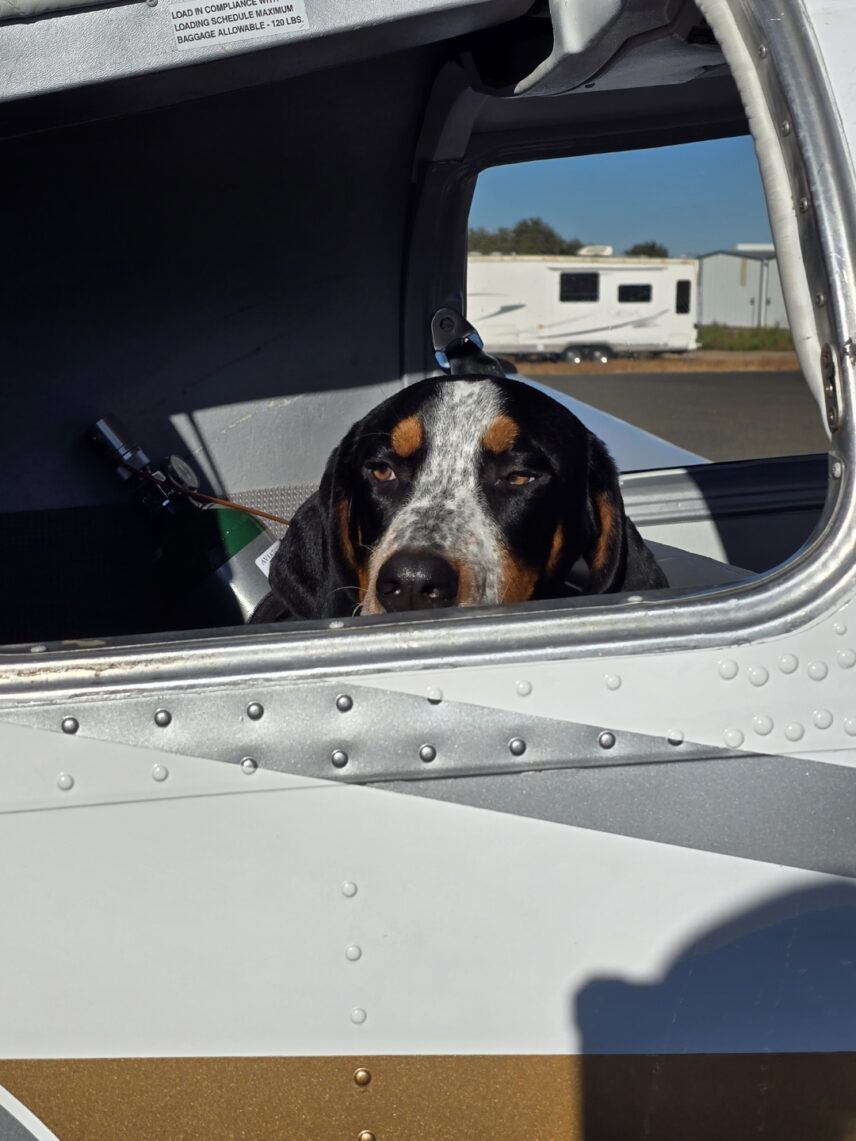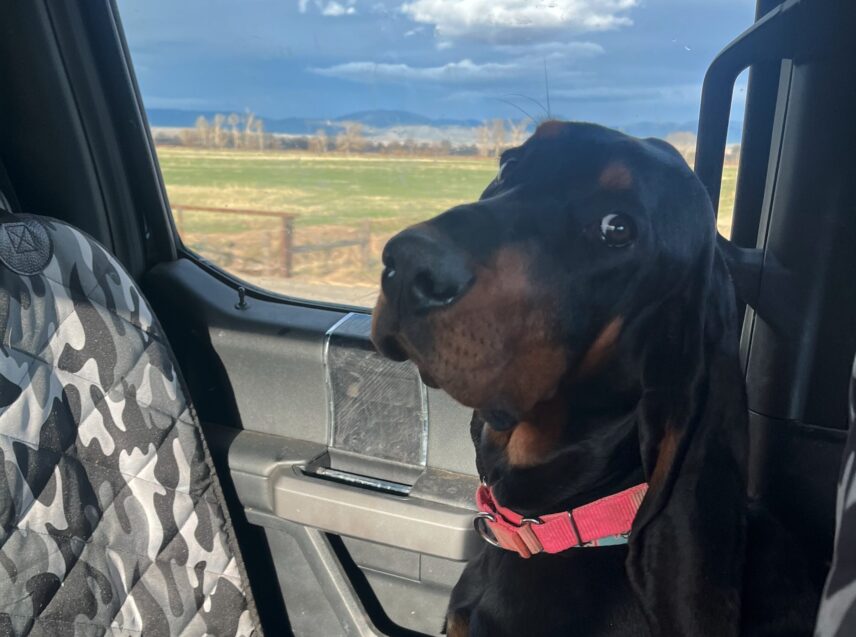Article begins
One evening in early 2023, my family and I drove to our local airport to meet Margaret, an animal rescue volunteer, and “Bella,” the hound that Margaret was transferring between the Mexican animal rescue for which she volunteered and the American animal rescue for which we volunteered. When we arrived at our meeting point in the baggage claim area, Margaret was chatting with Lydia, a volunteer with a third rescue who was waiting for “Hans,” the second dog that Margaret was bringing.
While we waited for the dogs to be delivered to us from the plane’s cargo hold, Margaret described their journey, which had begun more than twelve hours earlier when she arrived at her local airport in Cabo San Lucas and met the volunteer who had kept Bella and Hans in her home overnight. After the other volunteer gave Margaret all of the travel documents necessary to clear customs and bring the dogs into the United States, they walked the dogs and loaded them in airline-approved crates. Margaret then checked herself and the dogs in for the flights north, with the dogs officially traveling as “accompanied baggage” on her reservation. Margaret recounted that when she arrived in Los Angeles, she passed through immigration as a U.S. citizen and proceeded to baggage claim, where she received the dogs from a baggage handler. She presented her passport and the dogs’ paperwork to a customs agent, who quickly checked the documents and waved them through to the baggage recheck area. Margaret removed both dogs from their crates for a short walk and fresh water, then returned them to their crates and transferred them to airline personnel who loaded them on their next flight.

Just as Margaret finished her account, the doors for the “oversized baggage” hallway opened, and two airport employees wheeled out two carts, each loaded with a dog crate—one with Bella and one with Hans. My husband cut the zip-ties securing the doors to the crates, and Lydia and I snapped double leashes on the bewildered dogs and let them out to stretch their legs. We said our goodbyes, walked Bella outside to the dog relief area on the way to the parking lot, and loaded her and the crate into the cargo hold of our car. Barely thirty minutes after arriving at the airport, we were on our way home. Two days later, I drove Bella 100 miles to a long-term “foster family” (to use the kinship terminology of animal rescue) near Sacramento and returned the crate to Margaret for her trip back to her home and rescue work in Mexico. Several weeks later, Bella was already adopted and, as evident in the digital photos I received from her “foster mom,” was living the good life with her new family, frolicking on the beach near their home, not far from the airport where I had collected her.
On any given day in the U.S. and around the world, hundreds, if not thousands, of companion animals in need of homes travel by plane, car, truck, and boat between animal shelters, rescue organizations, and new families, often across continents, oceans, and national borders. Rescuers like Margaret who volunteer as “transporters” drive or fly thousands of miles every year to move these animals, while also providing food, shelter, veterinary care, and comfort along the journey. Most often, transporters use their personal vehicles, donating the cost of fuel and their time. Private pilots with a love of both flying and animals donate their planes, flying time, fuel, and landing fees. Some transporters volunteer for a specific rescue organization, while others work through charitable organizations devoted to transporting rescue animals. Best Friends Animal Society, Kindred Hearts Transport Connection, Rescue Express, Pilots N Paws, Pilots to the Rescue, and Flying Fur Animal Rescue are just a few among many.
Charitable foundations provide private planes or sponsor chartered flights, while commercial airlines and long-haul trucking companies offer pro bono and low-cost transport services. Alaska Airlines is well-known as a pet-friendly airline for its reliable and affordable services for regular customers and its nominal fees for rescue-related transports. One of the company’s charitable programs is a partnership with the Maui Humane Societyto move adoptable animals from overcrowded shelters on the islands to rescues and adopters on the mainland. Through the Wings of Aloha: Alaska Angels program, passengers booked on flights to the mainland can register as “Flight Angels” to escort an animal; rescue volunteers and airline staff coordinate everything on both ends of the journey, including dropping off animals at departure and meeting them upon arrival. There is no cost to travelers. Similar programs include the Delta Animal Rescue Transport (DART) and Southwest Animal Transport Team (SWATT), through which pilots, flight attendants, and other employees use their travel allowances to transport adoptable animals between shelters, rescues, and adopters. Individual airline employees can also gift their travel benefits to family and friends for rescue-related travel. This was the case for “Rosemary,” a cat that had been adopted from an Ohio-based rescue and was later abandoned by her owners at a rural California shelter a few hours from me. Through various rescue connections, I was contacted by the Ohio cat rescue that had originally placed Rosemary for adoption. They authorized me to “pull” her from the shelter and provide temporary fostering for a few days, until she was collected by two volunteers who traveled to California from Ohio on tickets donated by a fellow rescuer who worked for Southwest Airlines.

As the experiences of Bella and Hans show, rescue transports extend far beyond domestic national spaces and can connect animals with their new human families in other parts of the world. Rescue groups for Spanish hounds (galgos) move adoptable dogs from Spain to new families in Europe, rescues in Central America and the Caribbean move animals to the United States, and Pacific Island countries send animals to the United States and Australia. When the United States and allied countries pulled out of Afghanistan, rescues from around the world organized flights to remove abandoned dogs and cats and rehome them with American and European families and rescues.
With the exception of transport vehicles and planes emblazoned with rescue or corporate logos, most rescue animals travel in nondescript personal vehicles, and handoffs between transporters take place in everyday public spaces such as the parking lots of shopping centers, parks, or interstate rest areas. Passengers and drivers pull into parking spaces and hop out of their vehicles just long enough to transfer dogs attached to double leashes, cats in crates, paperwork, bedding, food, toys, and other items. They take a few snapshots that volunteers will later post on social media with tags such as “#freedomride” and send to fosters and adopters tracking the journey. Then people and animals are reloaded into vehicles. Off they go. An entire transfer can be handled in less than ten minutes. Similar scenes happen at small airports as pilots do handoffs on the tarmac, taking pictures of animal passengers secured in crates between seats or harnessed to seats, looking out the windows. Rescue migrations are thus so ordinary that they resemble virtually any other scene of people traveling with their pets.

The seeming simplicity of rescue journeys obscures the complicated work required to make them possible. Behind the scenes of these unremarkable and even invisible migration journeys are extensive networks of volunteers and professional staff who manage all of the logistics from vaccinations and veterinary clearances, including translations and notarizations for animals traveling internationally, to securing airline-compliant crates, leashes, collars, tags, toys, bedding, and cleaning materials for “accidents.” For animals that fly commercially, volunteers coordinate itineraries and commercial tickets for animals and their human escorts or work with private pilots and regional airports to schedule tight takeoff and landing times.
For road-based trips, volunteers with travel planning expertise use calendars and online mapping software to sketch out potential transportation routes, dividing journeys into short “legs” of usually one to two hours, identifying safe transfer stops, scheduling estimated arrival and departure times, and soliciting volunteer drivers to cover those legs. Once all the legs are filled—often a challenging and fluid task given weather, traffic, road construction, and other unexpected events—the itinerary is finalized. A volunteer connects everyone in a text chain or WhatsApp or Facebook Messenger group and shares itineraries, contact information, descriptions of transporters’ appearances and vehicles, and instructions for where to meet. My instructions for Bella included annotated maps of the airport that showed which entrance to use, the location of the baggage claim, and the nearest pet relief parklet. Depending on the distance, a transport for a single animal could take an entire day, or even several days. When possible, rescues try to bundle as many animals as possible into a single transport, sometimes including animals for multiple rescues in the same vehicle.
Rescue transports are not only practical strategies for saving adoptable animals, but they are also, perhaps more importantly, central to practices of family making. In an American context in which the vast majority of Americans with pets consider their pets to be part of their family (97% according to a recent Pew research survey), animal rescue explicitly uses kinship terminology and familial relationships with language such as “fostering,” “adopting,” “forever families,” and “fur babies,” among other terms. Rescue transports are presented as journeys of family unification, as evident in accounts by rescue volunteers and adopters who described falling in love with an animal—or even just the idea of a hypothetical animal—from afar, knowing that that animal was meant to be part of their family, and then relying on rescue transporters to make that dream a reality.

Rescue volunteers acknowledge this idea that families are made through transport when they arrange transports and then send updates, complete with pictures, of animals in transit to their foster or adoptive families. Madison recounted that almost immediately after her adoption application was approved, rescue volunteers began describing her dog as “your baby” in their correspondence about travel arrangements. Once her new dog was on its way for a two-day international journey, volunteers sent almost hourly updates with tracking information, complete with pictures, showing the care they were giving her new furry family member along the way. Rescue volunteers commonly send blankets, favorite toys, and other items that are intended both to comfort animals as they travel and to affirm the connections between those animals and the people who cared for them on their journeys to adoption. Traveling comfort gifts tangibly connect all of the individuals who cared for these animals until they arrive in their new families.
For other volunteers, transport activities become opportunities to create extended friend groups that they describe as their “second family.” Mark and Julie described the camaraderie they experienced when meeting other volunteers during transport runs. Even though Mark and Julie lived in separate states several hundred miles from one another, they found themselves connecting on multiple transports and became friends. They began planning transport runs so they and their families, including their personal dogs, could visit with each other. At a rescue-related social event, I watched as several volunteers and adopters unexpectedly realized that they had previously met on transport runs. Their conversation quickly turned personal and affectionate as they reminisced and swapped updates on animals they had moved.
Fred, an active foster and transporter, recounted how his effort to adopt a dog facing imminent euthanasia in a shelter located several states away was almost thwarted when a medical emergency prevented him from making the drive himself. A network of people who had adopted their dogs from Fred quickly arranged a transport journey to get his dog to him. The multi-leg journey was especially meaningful when it was completed early on Christmas Eve, despite hazardous snow conditions along the route—what some participants in the transport called a “Christmas miracle.” Several people involved in the journey commented that, because they were grateful to Fred for helping them complete their families, it was their turn to repay the favor and complete his family.
Even as animal rescuers celebrate the success stories of moving animals to new lives with their new families, they grapple with the ethics of transport as a form of family-making, especially when animals travel long distances across state and international borders. A persistent question for rescuers is whether it is appropriate to adopt an animal from afar when there are other available animals closer to them. Lisanne, who lives near London, wanted very much to adopt a dog from a local rescue, but she found it difficult to work with the rescues in her region because of their stringent requirements and the lengthy waiting period. After several months of searching, she finally found a rescue based in Spain that placed dogs with new families across Europe. In less than a week, Lisanne’s application was received, reviewed, and accepted, all of the paperwork was completed, and a team of volunteer transporters made the drive and ferry ride to bring her dog to her. She reported that, although she had wanted to save a dog in her local community, she decided that adopting from abroad still meant saving a life. Another adopter confessed to feelings of guilt when she learned that her adopted dog was traveling to her from abroad on the same day that the newly installed Trump Administration was deporting immigrants and breaking up families. Rescue transports offer an intriguing lens for rethinking how families are made through migration practices. It is rare for all participants in a transport chain to know one another, but when people come together at discrete, fleeting moments to move animals across long distances, they see themselves as part of a larger community of care and, more importantly, as crucial to helping other people make their families. When rescuers transport animals to foster homes or, more ideally, to their “forever families,” they transform abandoned and unwanted animals into someone’s “baby” and turn the promise of family into reality. In this type of family-making, the idea of family precedes the journey and then is realized not just by completion of the journey, but by the transfer of animals through multiple hands, vehicles, and homes. It is a form of family-making in which movement is generative, not limiting.

